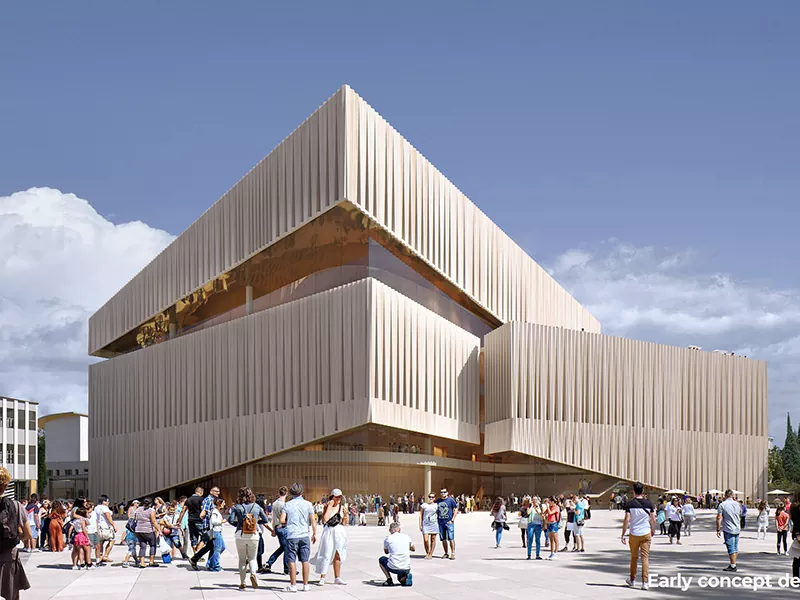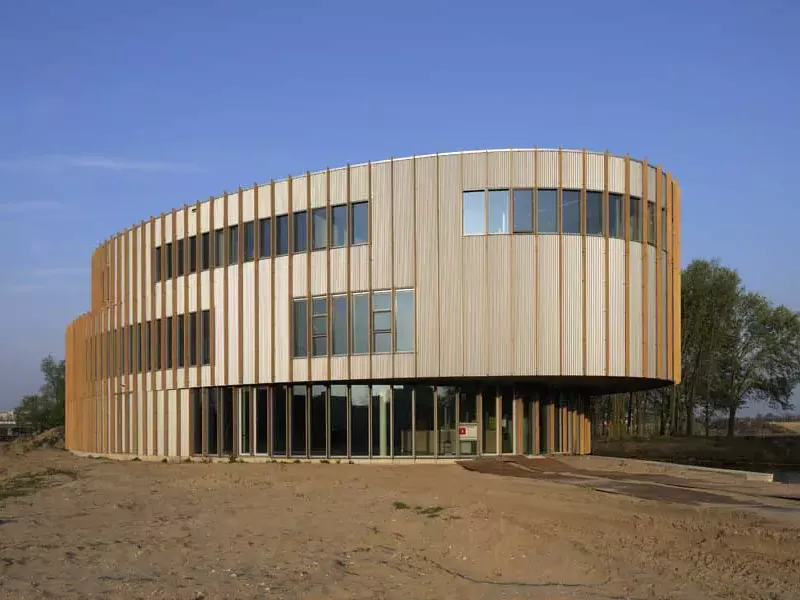QR Code

EIHE Steel Structure’s Steel Structure Theater Buildings represent the future of performance venue construction. They offer a combination of strength, design flexibility, efficient construction, acoustic excellence, sustainability, and adaptability that is unmatched by other materials.
The Benefits of Steel Construction
At the heart of the appeal of steel structure theater buildings lies the inherent strength and durability of steel. This material is renowned for its ability to withstand heavy loads and extreme weather conditions, ensuring that the theater remains standing for decades to come. Furthermore, steel's resistance to fire and pests adds an extra layer of protection to the building and its contents.
Design Freedom and Flexibility
One of the most significant advantages of steel construction is the design freedom it offers. Architects and designers can create theaters with complex geometries, large spans, and open floor plans, all of which contribute to a more immersive and engaging performance experience. Steel's modularity also allows for easier expansion and modification of the theater as needed, ensuring that it remains relevant and functional over time.
Efficient Construction Process
Steel structure theater buildings are often constructed using prefabricated components that are assembled on-site. This approach significantly reduces construction time and labor costs, minimizing disruption to the surrounding area and allowing for faster completion of the project. Additionally, steel's lightweight nature makes it easier to transport and install, further streamlining the construction process.
Acoustic Excellence
Acoustics are crucial in any theater, and steel structure buildings offer unique opportunities for optimizing sound quality. Special attention is paid to the design and construction of the theater's walls, ceiling, and floor to ensure that sound is evenly distributed throughout the auditorium and that unwanted noise is minimized. This results in a clearer, more immersive sound experience for audiences.
Sustainability and Environmental Impact
Steel is a highly recyclable material, making steel structure theater buildings more environmentally friendly than their counterparts. Additionally, the use of sustainable materials and practices during construction can further reduce the building's carbon footprint. Many modern steel structures are designed with energy efficiency in mind, incorporating features such as insulation, natural lighting, and efficient HVAC systems to minimize energy consumption.
Versatility and Adaptability
Steel structure theater buildings are not limited to traditional performance venues. They can be adapted to suit a wide range of uses, including concert halls, opera houses, multipurpose event centers, and even educational institutions. This versatility allows for the creation of unique and dynamic spaces that cater to the diverse needs of the communities they serve.
In conclusion, Steel Structure Theater Buildings offer a compelling combination of strength, design freedom, construction efficiency, acoustic excellence, sustainability, and versatility. They represent the future of performance venue construction, providing audiences with unparalleled experiences in modern, innovative, and enduring spaces
Steel Structure Theater Building details can be quite extensive, covering various aspects such as design, construction, materials used, and unique features. Below is a structured overview of some key details based on the information provided and general knowledge of steel structure theater buildings:
1. Design and Concept
● Architectural Style: Steel structure theater buildings often feature modern or avant-garde designs, utilizing the strength and flexibility of steel to create unique shapes and forms.
● Functional Layout: The design takes into account the functional requirements of a theater, including seating arrangements, stage areas, backstage facilities, and circulation routes.
● Visual Impact: Steel structures allow for the creation of eye-catching exteriors, enhancing the visual impact and landmark status of the building.
2. Structural System
● Steel Frame: The primary structural system consists of steel beams and columns, which support the entire building and distribute loads effectively.
● Span Capability: Steel structures offer excellent span capabilities, allowing for large, open spaces without internal columns, which is ideal for theaters.
● Roof Structures: Roofs can be designed using various steel components, such as trusses, arches, or grid systems, to support the weight and provide stability.
3. Materials Used
● Steel Grades: High-strength steel grades are typically used to minimize material usage and reduce overall weight.
● Connections: Steel connections are critical for transferring loads and maintaining structural integrity. They can be welded, bolted, or a combination of both.
● Coatings and Finishes: Steel components are often coated with corrosion-resistant materials, such as paint or galvanization, to extend their lifespan.
4. Construction Process
● Prefabrication: Steel components are often prefabricated in factories, ensuring accuracy and quality control before installation.
● Erection: Prefabricated steel components are then transported to the site and erected using cranes and specialized equipment.
● Assembly: Once on site, the components are assembled and connected to form the complete structural system.
5. Unique Features and Examples
● National Centre for the Performing Arts (China): As mentioned in one of the reference articles, the National Centre for the Performing Arts (NCPA) in Beijing, also known as the National Grand Theatre, is an example of a steel structure theater building with a unique design. Its elliptical shape and lack of internal columns demonstrate the capabilities of steel construction.
● Sydney Opera House (Australia): While not entirely steel-framed, the Sydney Opera House features a complex steel and concrete roof structure that supports its iconic shell design.
● Customized Solutions: Steel structure theater buildings can be customized to meet specific requirements, such as size, seating capacity, and aesthetic preferences.
6. Benefits and Challenges
● Benefits:
Durability and long lifespan
Resistance to natural disasters like earthquakes and hurricanes
Fast construction speeds due to prefabrication
Versatility and design freedom
● Challenges:
Cost considerations, especially for large-scale projects
The need for specialized design and construction expertise
Ensuring fire safety and compliance with building codes
7. Conclusion
Steel structure theater buildings represent a combination of advanced engineering, innovative design, and functional requirements. By leveraging the unique properties of steel, architects and engineers can create iconic and sustainable structures that serve as cultural hubs and landmarks for generations to come.
1. What are the advantages of using steel for theater building construction?
Answer:
● Durability and Longevity: Steel structures are known for their durability, with a lifespan exceeding 50 years. This ensures that theater buildings can withstand the test of time and continue to serve the community for decades.
● Design Flexibility: Steel offers unparalleled design flexibility, allowing architects to create unique and visually stunning structures that meet the functional requirements of theaters. Large, open spaces without internal columns can accommodate stage areas and seating arrangements.
● Speed of Construction: Steel components are often prefabricated in factories, which significantly reduces construction time. Once on site, they can be quickly assembled and erected, minimizing disruption to the surrounding area.
● Resistance to Natural Disasters: Steel structures are highly resistant to natural disasters like earthquakes and hurricanes, providing a safe and secure environment for theatergoers and performers.
2. How much does a steel structure theater building cost?
Answer:The cost of a steel structure theater building can vary significantly depending on various factors such as size, complexity, location, and materials used. However, a rough estimate based on market prices could range from around US40.00toUS150.00 per square meter for the steel structure alone. The total cost would include additional expenses like design, engineering, construction labor, finishes, and equipment.
3. What are the standard materials used in steel structure theater buildings?
Answer:
● Steel beams and columns form the primary structural system of steel structure theater buildings. High-strength steel grades are typically used to minimize material usage and reduce overall weight.
● Connections between steel components are critical for transferring loads and maintaining structural integrity. These can be achieved through welding, bolting, or a combination of both.
● Steel components are often coated with corrosion-resistant materials, such as paint or galvanization, to extend their lifespan and protect against the elements.
4. What are some examples of famous steel structure theater buildings?
Answer:
● National Centre for the Performing Arts (NCPA), Beijing, China: The NCPA is a renowned steel structure theater building known for its elliptical shape and lack of internal columns. Its unique design showcases the capabilities of steel construction.
● Sydney Opera House, Australia: Although not entirely steel-framed, the Sydney Opera House features a complex steel and concrete roof structure that supports its iconic shell design.
● There are many other examples of steel structure theater buildings around the world, each with its own unique design and story.
5. What are the challenges associated with building a steel structure theater?
Answer:
● Cost: Steel construction can be more expensive than traditional materials like concrete, especially for large-scale projects. Careful budgeting and cost control are essential.
● Specialized Expertise: Building a steel structure theater requires specialized design and construction expertise. It is crucial to work with experienced architects, engineers, and contractors who understand the unique requirements of theater buildings.
● Compliance with Building Codes: Ensuring compliance with local building codes and regulations can be challenging, particularly regarding fire safety and accessibility requirements.
● Site Conditions: Site conditions, such as soil type, weather, and access to materials, can affect the construction process and require careful planning and management.


Address
No. 568, Yanqing First Class Road, Jimo High-tech Zone, Qingdao City, Shandong Province, China
Tel

Copyright © 2024 Qingdao Eihe Steel Structure Group Co., Ltd. All Rights Reserved.
Links | Sitemap | RSS | XML | Privacy Policy |
TradeManager
Skype
VKontakte
